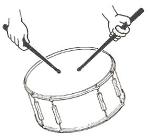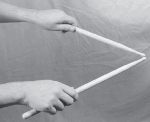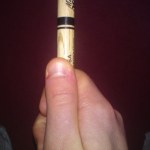How To Hold Drumsticks
How to Hold Drum Sticks: The Most Common Methods
One of the most important things to know about drumming before you ever strike your first roll on the snare drum is how to properly hold a set of drum sticks. If you hold a set of sticks without knowing the how’s and why’s of proper drum stick technique, it can seriously hinder your playing ability, progression and sound.
There are three common ways that drummers hold their sticks that have become timeless standards. By holding your sticks the right way, you will naturally have more control over the amount of rebound and movement your sticks have. It’s this kind of control that separates a great drummer from a mediocre one – that and tons of practice.
Three Most Common Grips for Holding Drumsticks
While there are numerous acceptable and widely used drumstick grips and techniques; we will take a look at the three most common grips:
- Traditional
- Matched
- French
Take some time to try each one of these and get a feel for which one fits the style you want to play. Knowing all three will also give you more options when you want to move beyond the rudiments and into more interesting styles.
 Traditional Grip:
Traditional Grip:
Popular Jazz Drumming Technique
The traditional grip is the oldest style mostly seen among jazz drummers. This grip allows for a lot of finesse and fast fills, but since the grip is loose it’s not very well suited to the loud crashing sounds required for modern rock and roll. However many rock and roll drummers can be seen using this grip.
To use the traditional grip you’ll place the sticks in your hands with your palms facing the ceiling and wrap your first two fingers around the stick just behind the balancing point. With this grip you’ll find it easy to play super-fast strokes, and you’ll have supreme control over the kit’s dynamics.
 Matched Grip
Matched Grip
Most Common Drumming Technique
The matched grip is the most popular grip among drummers covering a wide range of genres. Chances are that when you watch your favorite drummer they are using this grip most of the time. The matched grip is a jack of all trades because it provides a lot of control and versatility when working around the entire kit.
To hold a stick with the matched grip, you place the stick in your hand with the middle point right under the middle joint of your index finger. You then wrap the rest of your fingers around the stick like you are shaking someone’s hand. Your thumb should be resting on the side of the stick opposite to your index finger. The stick should feel very secure when you swing your hands around, but the stick should also be able to pivot somewhat freely so you can control the dynamics.
 French Grip:
French Grip:
For Super Fast Fills
The least common grip is the French grip. This grip allows the most speed for playing fast drum fills, but it is also the most delicate. When practicing the French grip, be sure to warn onlookers of the dangers of flying drum sticks. To use the French grip, your palm does not touch the stick at all, and your fingers do all of the controlling.
Summary
Regardless of the style you play it’s a good idea to learn how to hold your drum sticks from a variety of disciplines. By familiarizing yourself with a few different methods you’ll be able to choose what technique is the best for the style you are trying to play.